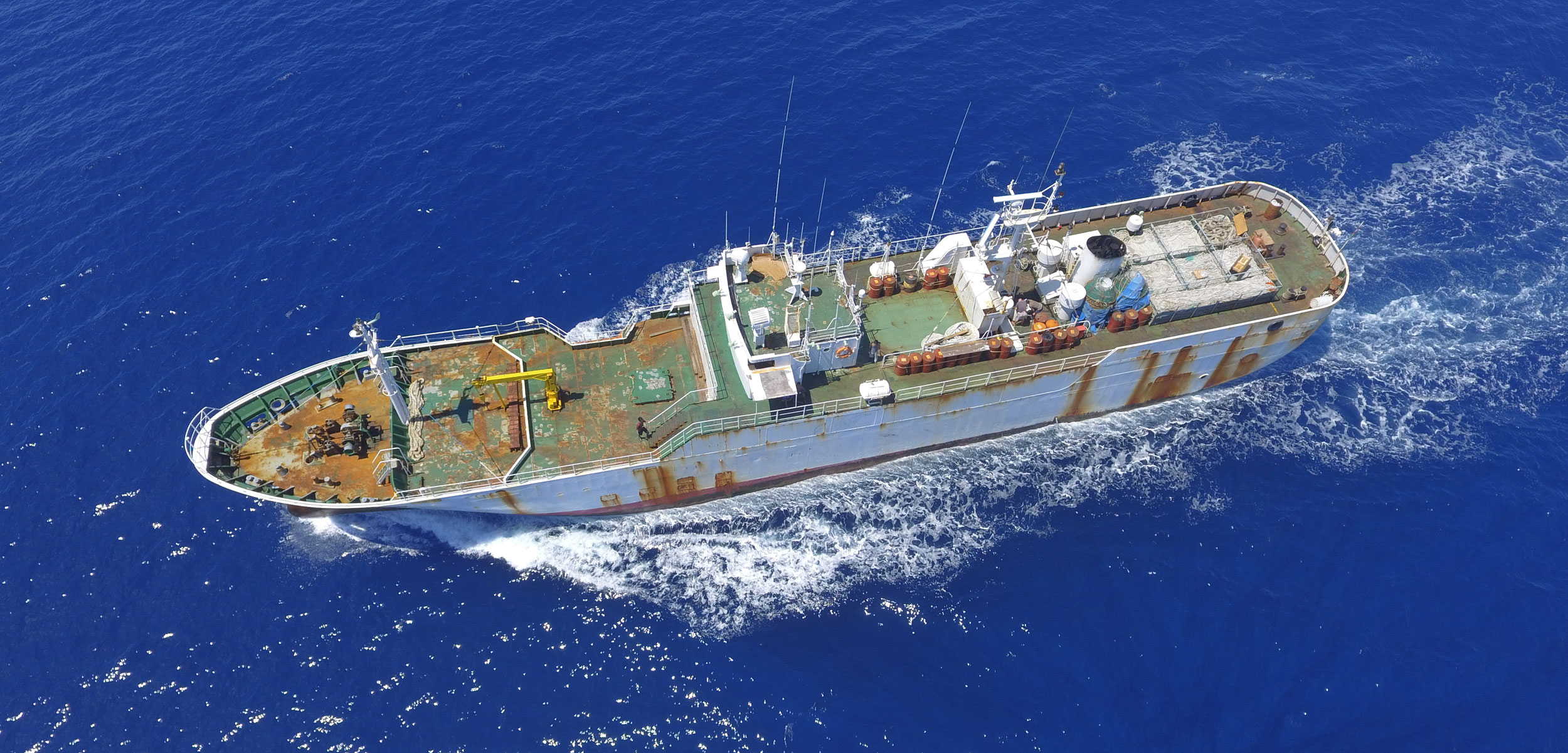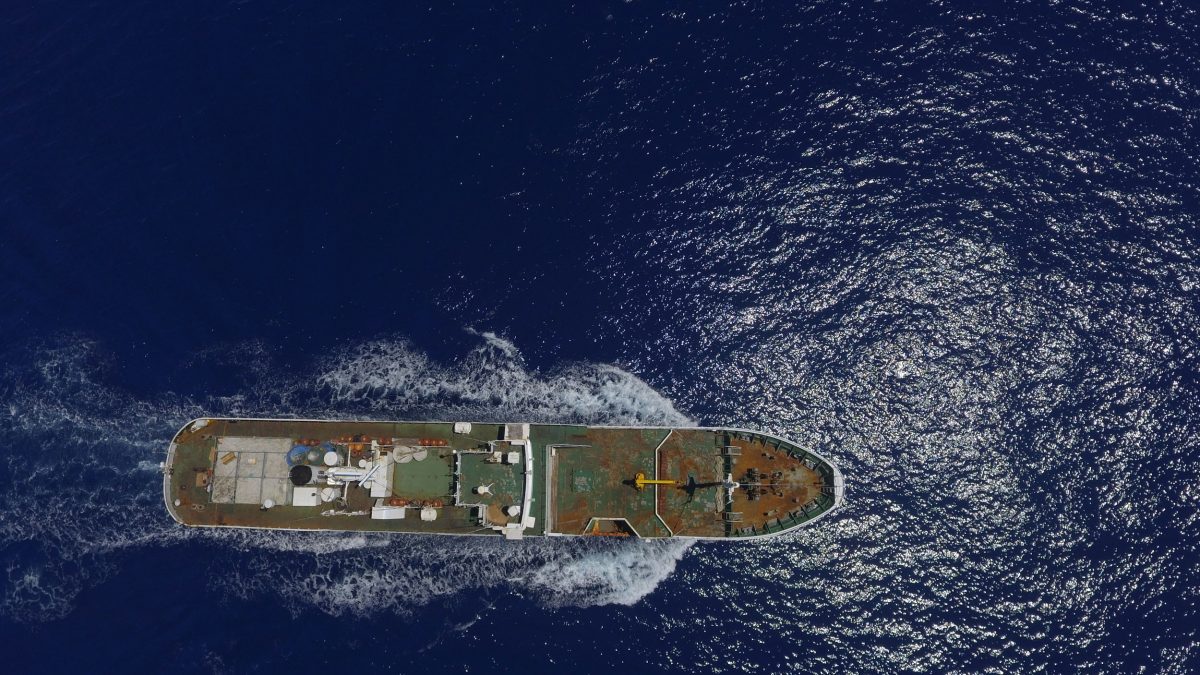Catch Me If You Can: The Global Pursuit of a Fugitive Ship
The tale of a notorious fishing vessel shows just how difficult combating illegal activity at sea can be.
Article body copy
In the middle of the Indian Ocean in March 2018, a rusty fishing boat cut through the waves as a similarly sized but far-sleeker vessel called the Ocean Warrior followed in hot pursuit.
At 54 meters long and nine meters wide, the Ocean Warrior is equipped with four engines, long-range fuel tanks, a helicopter landing pad, and a water cannon capable of hosing its target with about 20,000 liters each minute. The Sea Shepherd Conservation Society had custom built the US $8-million vessel for running down Japanese whaling ships in the Southern Ocean, but had recently been using it to patrol the waters off Tanzania for illegal fishing boats in partnership with the Tanzanian government and a task force representing eight East African countries called FISH-i Africa. Sea Shepherd provided the boat, crew, and fuel; FISH-i Africa, offered advice borne of experience counteracting illegal fishing operations; and Tanzania provided law enforcement agents who had the authority to apprehend vessels.
The 20-day patrol was supposed to be local, but on the third day, the ship’s team had received a call from a contact in Tanzania: a notorious illegal fishing vessel, the STS-50, had escaped from port in Maputo, Mozambique, where authorities were supposed to be guarding it. Was there anything the Ocean Warrior could do to help? The team agreed to give chase.
The STS-50 was a 452-tonne, 1980s-era former longliner originally from Japan. It was well known in maritime circles under its previous names—the Andrey Dolgov, the Sea Breeze, the Ayda—for poaching Antarctic and Patagonian toothfish (also called Chilean sea bass), two lucrative cod species from the Southern Ocean. Authorities believe the STS-50 operated illegally for 10 years or so and looted up to $50-million worth of the fish, which can grow to 120 kilograms and live for 60 years. Interpol had issued a purple notice for the vessel—an international request for information about the STS-50’s criminal activity. But the vessel’s owners and captain had been evading authorities for years with a typical bag of tricks: registering the boat to nations with lax rules; using shell companies to obscure ownership; forging documents; and spoofing the most advanced satellite surveillance.
The STS-50’s captain was also a master of escape; the getaway from Maputo was the third time he had given port authorities the slip. This time, the Ocean Warrior crew was determined to keep their eyes on the target. But, after chasing the STS-50 for more than 1,600 kilometers across the Indian Ocean, the Ocean Warrior was low on fuel. The predicament forced the Sea Shepherd captain, Mike Dicks, to make an agonizing decision: turn back. It looked like the STS-50 was about to disappear yet again.
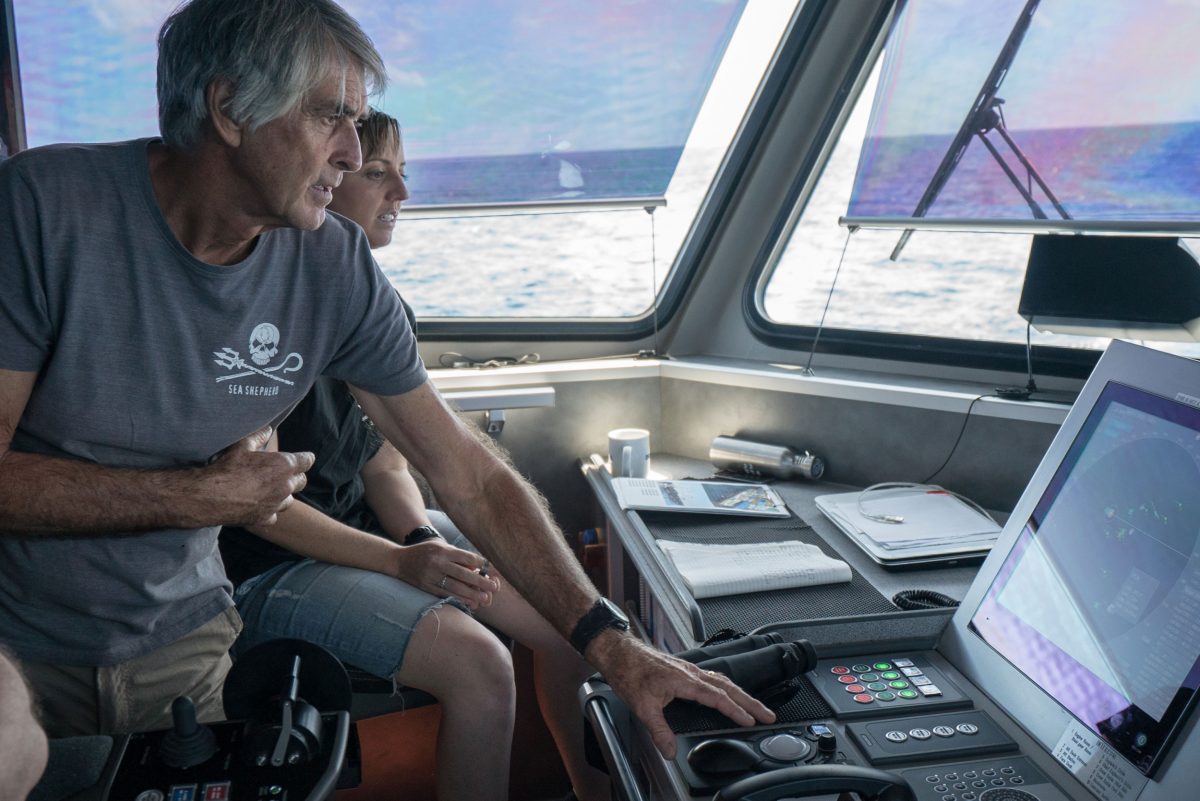
Mike Dicks of the Sea Shepherd Conservation Society and his crew trail the STS-50 after it flees from Mozambique. Photo courtesy of Sea Shepherd
Instead, something else happened. On April 6, 2018, less than two weeks after the Ocean Warrior abandoned chase, Indonesian authorities captured the STS-50 near Banda Aceh. It was a rare victory against an illegal fishing boat, and it highlighted a growing international movement to tackle fishing crimes.
In Latin, the high seas are maria libera—meaning “free seas”—a term that helps explain why criminals see these parts of the ocean as easy places to get rich. Historically, illegal fishing has been nearly impossible to counteract, especially on the high seas, which begin where national jurisdiction ends—370 kilometers from a nation’s shore—and cover two-thirds of the world’s oceans. A loose patchwork of laws and international treaties govern these parts of the oceans, but in most places, they’re rarely enforced, allowing illegal fishing and a plethora of related crimes to go unpunished. Vessels that fish illegally are often involved in human trafficking and drug smuggling while contributing to plummeting fish stocks and degraded marine ecosystems. Experts estimate that up to 20 percent of the world’s total catch (fish and other marine fauna) falls under illegal, unreported, and unregulated (IUU) fishing. That’s more than 23 million tonnes of seafood stolen from the seas annually—or one out of every five wild-caught fish sold on the market—worth $23.5-billion.
Just six years ago, the STS-50 probably would have gotten away, says Per Erik Bergh, the secretary of Stop Illegal Fishing, an Africa-based nonprofit. But around that time, international authorities and nonprofits began working together more closely to take down illegal vessels. As the players gained one another’s trust, a powerful weapon in the fight against illegal fishing emerged. Ending the STS-50’s reign of pillage had taken countless hours of work by dozens of collaborators across 40 nations: fishers, port authorities, government officials, and representatives from existing coalitions designed to combat marine crime.
For Peter Hammarstedt, the director of ship operations for Sea Shepherd who helped coordinate the Ocean Warrior’s pursuit from land, the effort to capture the STS-50 was a testament to the global nature of fisheries crime—and the global solutions required to stop it. “It was exciting,” Hammarstedt says, “to know that all these countries were working together to make sure this one vessel would not get away.”
There were major challenges and a bit of luck, Bergh says, but in the end, “it all worked and you just don’t often see that.” The demise of the STS-50 served as proof that the collaborative enforcement model was making progress.
In February 2018, about a month and a half before the STS-50’s capture, Antoine Jeulain was sitting alone in his office in Antananarivo, the capital of Madagascar, when he received disturbing news. At the time, he was the French liaison officer at the Madagascar-based Regional Maritime Information Fusion Center, a new information sharing initiative for combatting illegal fishing in the western Indian Ocean.
A vessel called the STS-50 had arrived at Fort Dauphin (also known as Tolagnaro), a port on the island’s southeast coast. The boat was evidently registered to Togo, a small West African country, and had come to port because of mechanical issues.
An inspector with the Madagascar fisheries control agency had boarded the STS-50 and found suspicious documentation. He took a picture and sent it to the Indian Ocean Tuna Commission (IOTC), an intergovernmental organization that manages tuna in the region. The IOTC confirmed that the document was forged. When Jeulain heard the news through his network, he began making inquiries of his own. From Interpol, he learned that the STS-50 was wanted by seven nations for illegal fishing. Jeulain then checked to see if the vessel’s certification was valid. An official from Togo sent him the response: “We wish to inform you that it’s fraud.”
But by the time Jeulain received the email, the STS-50 had left Fort Dauphin. He relayed pictures and the STS-50’s last known positions to his networks in African ports, hoping they would be ready when the rusty ship re-emerged.
At that point, the STS-50 might have remained just another one of the numerous illegal fishing vessels that have eluded capture for years. An estimated 168 IUU fishing vessels operate on oceans around the world.

The STS-50 went by several different names over the years. It started out in Japan in 1985 as the Shinsei Maru No. 2. Photo courtesy of Sea Shepherd
Illegal fishing has confounded fisheries managers for years, says Christian Bueger, an expert in maritime security and a professor of international relations at the University of Copenhagen in Denmark. Coastal nations have typically viewed the issue mainly as an environmental management problem instead of as organized crime.
But in many parts of the world, illegal fishing has become a clear threat to coastal security. In Somalia, for example, some locals who have taken to piracy claim it’s a way of guarding their waters against foreign poachers. As the impacts of illegal fishing ripple out, countries are taking the problem more seriously.
To address mounting fisheries crimes, Interpol, with support from Norway and a grant from the Pew Charitable Trusts, launched Project Scale in 2013. Nonprofits such as Sea Shepherd and FISH-i Africa, which is associated with Stop Illegal Fishing, and fusion centers such as the one Jeulain was helping build (themselves cooperative entities representing multiple nations) joined the effort. A key part of the project’s work is determining which vessels pose a high risk of carrying out illegal activity based on past behavior and then sharing that information among port authorities, coast guards, and fisheries inspectors around the world. The partners look for boats that have forged paperwork, frequently changed their names and countries of registration, or been involved with illegal fishing in the past. The expertise they honed proved invaluable when the Project Scale players joined the hunt for the STS-50.
The Southern Ocean comprises a swath of sea encircling Antarctica and makes up roughly 15 percent of the world’s ocean area. Though often thought of as too inhospitable for human activity, the region is hardly an untouched wilderness. Seven countries lay territorial claim to slices of the region and the resources it contains. In the late 1700s, people first hunted Antarctic fur seals, driving them close to extinction by 1825. They moved on to elephant seals and some species of penguins for their oil. Whaling began soon after, and then krill fishing began in the late 1970s.
In response to the growing commercial interest in the region, a group of 26 countries got together and formed the Commission for the Conservation of Antarctic Marine Living Resources (CCAMLR), established by international convention in 1982 with the goal of protecting Antarctic marine life. CCAMLR sets the fishing quotas for the Southern Ocean, but illegal fishing vessels can easily sidestep the directives: boats registered to non-CCAMLR member countries are not subject to the commission’s rules, making prosecution all but impossible.
Before the 1990s, few people had heard of the toothfish. A few decades before at a port in Chile, Lee Lantz, an American seafood merchant on the hunt for new fish species, had come across a fish with buttery, mild flesh high in omega-3 fatty acids that was hard to overcook. But the toothfish, with fearsome teeth and a protruding lower jaw, looked as ugly as its name, so Lantz rebranded it as Chilean sea bass. It became so popular that a single fish could sell for thousands of dollars. By the mid-1990s, CCAMLR reported that illegal toothfish hauls had hit over 68,000 tonnes—more than twice the legal quota. Increased surveillance and arrests by countries like Australia and New Zealand have helped curb the poaching activity, but it remains a serious problem.
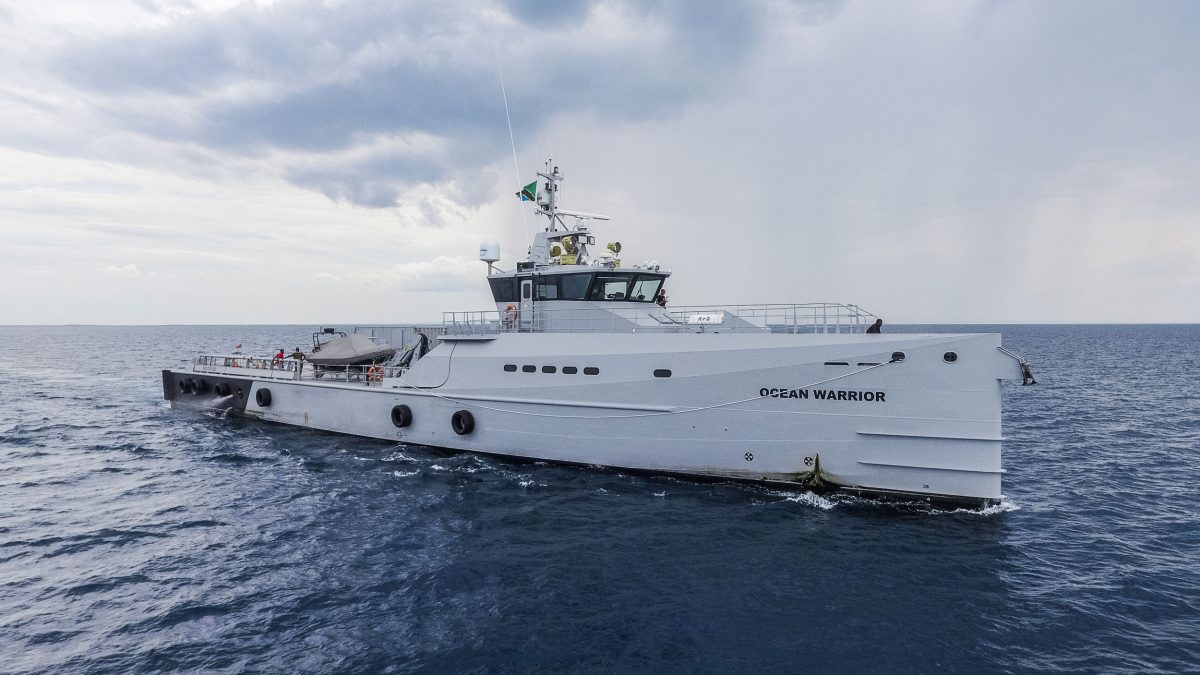
Sea Shepherd’s Ocean Warrior was built as an anti-whaling vessel but has been used to combat illegal fishing. Photo courtesy of Sea Shepherd
Selling the illegally caught fish is relatively easy to get away with if port inspectors do a poor job of investigating the vessel, explains Peter Horn, the project director for the Pew Charitable Trusts’ ending illegal fishing program. All the captain has to do is misreport the catch, claiming for instance that the crew caught one type of fish when in fact it caught another; lie about the quantity of fish caught; or pretend to have fished in a different area. The end result is a market with so many illegally caught fish that “there’s a reasonable chance that you have inadvertently bought some,” Horn says.
For IUU fishing boats, the Southern Ocean is delightfully remote—they haul up fish nearly 1,500 kilometers from the southernmost edge of New Zealand’s territorial waters, where it’s difficult for even the closest countries to sustain regular coast guard vessel or aerial patrols. Before the STS-50 arrived on the scene, a notorious fleet of fishing vessels known as the Bandit 6 had been poaching toothfish in the Southern Ocean from 2003 to 2016. With the launch of Project Scale, Sea Shepherd began helping Interpol target the vessels and their owners, including a Spanish mafia group called Vidal Armadores.
One takedown involved a 110-day chase led by a Sea Shepherd vessel across three oceans. The hunt for the illegal ship, the Thunder, ended in April 2015, when its Chilean captain intentionally sank the vessel off the west coast of Africa.
Afterward, Project Scale investigators discovered the identity of the Thunder’s owner from his insurance claim, which included the loss of 32 tonnes of illegally caught toothfish. “This is how brazen they were,” says Hammarstedt.
In 2015, a court in São Tomé and Príncipe, an island nation off the west coast of Africa, convicted the Thunder’s captain and two of its crew members on several charges tied to illegal fishing and collectively fined them over $17-million.
By early 2016, the five other Bandit 6 vessels had met similar fates, and for a while, the Southern Ocean was free from major illegal fishing operations.
With the Spanish vessels gone, the STS-50 moved in to fill the void.
The STS-50 had been fishing illegally around the world at that point for eight years under a variety of names, likely selling its catch to middlemen who knew it was illegal, says Bergh of Stop Illegal Fishing.
The crew would have changed often and it’s possible some would not have known their activities were criminal, but the senior officers like the Russian captain and the first mate would have been fully aware, says Bergh.
It wasn’t until the fall of 2016 that authorities flagged the vessel for possible violations. After its crew unloaded what looked like toothfish in the port of Weihai, China, raising suspicions that it might have been illegally caught, officials conducted DNA testing that confirmed it was, in fact, toothfish. To legally catch toothfish, vessels must be registered in a country that is a member of CCAMLR—otherwise the catch falls into the category of “unregulated.” The STS-50 was registered to Cambodia, which is not a member. In any case, as Cambodian officials later confirmed, the boat’s registration was forged. But before anyone could stop it, the vessel fled across the Indian Ocean.
In January 2017, New Zealand and Australia requested Interpol issue the purple notice, and officials in partner countries went on high alert. By this time, the vessel had been renamed the Sea Breeze and then again the Ayda. When it arrived at ports, the captain, Aleksandr Matveev, presented forged documents to obscure its identity and claimed the boat belonged to at least eight different flag states including Togo, Nigeria, and Bolivia—all countries with lax maritime laws. Registering a ship under one of these so-called flags of convenience is a common tactic used by owners of IUU fishing vessels since a ship generally falls under the jurisdiction of the flag state.
The vessel’s owners disguised their identities through a convoluted network of shell companies—businesses that exist only on paper. A 2019 report by the Center to Combat Corruption and Cronyism notes that “large-scale reform is needed in the global fishing sector to improve how vessel owners report ownership information and prevent the exploitation of opaque jurisdictions and flag states.”
Before abandoning their pursuit of the STS-50, the Ocean Warrior crew flies a drone over the illegal vessel. Video courtesy of Sea Shepherd
A year after the STS-50 left Weihai, the vessel returned to China and was arrested but fled the same day. The ship evaded authorities until February 2018, when the fisheries inspector in Madagascar found the suspicious document on board.
“Madagascar was really brilliant,” says Bergh, referring to the inspector’s decision to alert the IOTC. “They had their suspicions and sent them out.” Had they not done that, he adds, it might have taken the authorities far longer to track down the vessel.
As soon as the STS-50 fled Fort Dauphin, various players, including FISH-i Africa and Stop Illegal Fishing, began tracking the vessel via its automatic identification system (AIS), which emits a location signal that can be picked up by radio equipment and satellites to help vessels avoid collisions at sea. Those groups shared that information with other players, including Jeulain at the Regional Maritime Information Fusion Center and officials in Indonesia, Australia, and New Zealand. By pooling their various intelligence sources, Jeulain says, they could increase their strategic advantage on the STS-50.
“You send the ball over to another player who can bring added value to the play,” he adds.
On February 27, 2018, two weeks after the STS-50 had slipped away from Madagascar, Jeulain received another email, this time from one of his contacts in Maputo. The informant said the vessel had moored near Maputo a few hours earlier. The STS-50 had not requested permission to enter Mozambican waters, and authorities boarded the vessel to inspect it. They found fishing gear, though the boat was not authorized to fish. Mozambican officials arrested the vessel, brought it to port in Maputo, and confiscated the crew’s passports—20 Indonesian, eight Russian, and two Ukrainian.
But two weeks later, on March 18, the STS-50 fled again. How such a large vessel wanted for illegal fishing could have escaped from a major port remains a mystery. (A person familiar with the case refuses to speculate on what may have happened but says that Mozambique is a country where “cash is helping you a lot.”)
When news of the ship’s getaway reached Gary Orr, who monitors commercial fishing for the New Zealand government, the elation he had felt when the vessel was detained was quickly replaced by crushing disappointment. “The chase and the apprehension of the bad guys is what it’s all about if you’re an investigator; it’s what you live for,” Orr says.
With investigators on high alert, the STS-50 tried to evade tracking by periodically switching off its AIS and using a generic Maritime Mobile Service Identity (MMSI) number, a nine-digit code that is supposed to be unique to each vessel. With the generic identification number, the STS-50 was able to hide under other ships’ transmission signals, says Bergh, “a bit like everybody trying to talk on the same frequency on a radio.” Specialists at Trygg Mat Tracking (TMT), a Norwegian nonprofit that provides vessel tracking analysis to FISH-i Africa, were able to decipher the STS-50’s intermittent satellite signals and detect where the vessel really was.
It was like playing a game of cat and mouse in an area larger than the Australian continent. On March 20, Jeulain’s phone pinged. It was a WhatsApp message from one of his regular informants, the captain of a fishing boat off the west coast of Madagascar. He had spotted the STS-50.
The STS-50 was heading northeast, toward the port of Toliara on Madagascar’s west coast, just as TMT experts had thought. Bergh, who was kept abreast of the tracking efforts, concluded that, at its current speed, the vessel might be there in 14 to 16 hours.
He fired off an email to Jeulain, notifying him of its likely destination.
“OK Per,” Jeulain wrote back. “I have a network of informers at Tuliare [another name for Toliara] and Morombe. I will send the picture of the F/V [the STS-50] so that my network can spot it if it ever shows up.”
At 63, the Ocean Warrior’s captain Mike Dicks had served as skipper on two previous Sea Shepherd campaigns. A former airline pilot in Hong Kong, Dicks was a keen sailor and had flirted with becoming a marine biologist. The previous summer, Dicks had helped arrest 15 Chinese vessels in East Timor for illegal fishing and human rights abuses. When officials from East Timor raided the boats, they found freezers jammed with sharks—many of them endangered.
When Dicks received notice that the STS-50 had fled detention in Mozambique, he had to figure out where it would try to flee. Though TMT was tracking the ship, no one was certain where it was headed. “It was more of a guess-and-check type scenario,” as Orr puts it. A cyclone off the east coast of Madagascar left the STS-50 with just one likely escape route: northward up the Mozambique Channel and then east across the Indian Ocean into international waters.
A few days later, Dicks received position reports that the STS-50 had crossed the Mozambique Channel and was heading north along the west coast of Madagascar, as predicted. Dicks steered the Ocean Warrior southeast from Tanzania, hoping to intercept it.
To conserve fuel, he kept the speed slow, gradually closing in on the STS-50 without raising suspicion in the other vessel’s crew that they were being pursued.
Ahead, the STS-50 passed Comoros, off the north coast of Madagascar, and was headed east toward the international waters of the Indian Ocean—exactly as Dicks had guessed.
Under the United Nations Convention on the Law of the Sea, the STS-50 was a stateless vessel due to its forged paperwork, which meant that any country could seize it in international waters. Tanzania, which had sent officers out on the Ocean Warrior, had volunteered.
“That was an amazing testament to Tanzania’s commitment for fighting environmental crime,” says Sea Shepherd’s Hammarstedt. Most countries are reluctant to go after rogue vessels. Now, Tanzania, with Sea Shepherd’s help, would be responsible for bringing the STS-50 back to port and footing the bill for prosecuting the vessel.
But international waters were still a long way away. To get to where Tanzanian authorities could board the STS-50, the Ocean Warrior would have to travel far into the Indian Ocean, past the territorial waters of Madagascar, Mauritius, and Seychelles—at least 1,800 kilometers from the Tanzanian coast, according to Dicks’s calculations—which put the ship at the far edge of its fuel supply. Without enough diesel, the Ocean Warrior would have to make the return trip on its electric engine—at a much slower pace—pushing the homeward journey to 10 days. There was a chance, though, that with permission from the relevant nation, the Ocean Warrior team could arrest the STS-50 in territorial waters.
As the chase progressed, Dicks saw that it was becoming a logistical nightmare. How would they get the STS-50 all the way back to Dar es Salaam, Tanzania’s closest major port? Only three of the Tanzanian officials aboard the Ocean Warrior were armed and they would need to guard the 25 people aboard the STS-50 for the entire journey. These are the same people who had just escaped port twice in the past four weeks. What if they were aggressive? Or had guns? Dicks was not certain he could guarantee the safety of the Tanzanians or the other 18 people aboard the Ocean Warrior.
Given Dicks’s growing concerns, Tanzania requested permission from Seychelles to seize the vessel while it was in Seychellois territorial waters, but their inquiries went unanswered.
By this point, the Ocean Warrior had nearly caught up to the STS-50. Dicks kept them 24 to 32 kilometers away—close enough to see the STS-50 on the radar. As they approached international waters, it was looking increasingly unlikely that they could apprehend the STS-50. The decision to turn back just beyond the island of Mauritius was “gut wrenching,” says Dicks. “We’d been chasing them for a week and we just had to let it go.”
Before turning around, Dicks steered the Ocean Warrior closer to the STS-50 while the crew deployed a drone to take pictures in hopes that it would help authorities eventually identify the vessel and capture it.
The STS-50 charged on toward Indonesia, on the other side of the Indian Ocean. But it had picked the wrong country to escape to.
With the STS-50 cutting across the ocean, Hammarstedt messaged Mas Achmad Santosa, the head of Indonesia’s storied task force for combating illegal fishing. Since 2014, the country, which contains 17,000 islands, has blown up more than 400 illegal fishing boats.
In February 2016, the Indonesian navy, with Sea Shepherd assisting, had caught the last of the Bandit 6 ships—a vessel called the Viking. A few weeks later, Indonesian officials loaded the Viking with explosives and blew it up.

The illegal fishing boat known as the Viking, captured before the STS-50, in Indonesian waters. Photo by ZUMA Press, Inc./Alamy Stock Photo
“This is to serve as a deterrent to others,” Susi Pudjiastuti, Indonesia’s fisheries minister at the time, told a group of reporters as she stood on the beach while the Viking smoldered behind her. “You may go freely in the rest of the world, but once entering Indonesia, this is the consequence.”
To Jeulain, Bergh, Hammarstedt, and the huge network of people invested in the STS-50’s capture, the end looked to be in sight. Indonesian authorities were ready to intercept the vessel as soon as it entered its waters.
Still, no one knew exactly where the STS-50 was. Without the Ocean Warrior following directly behind the vessel, they had to rely on its AIS signal to determine its location, but the STS-50 was transmitting only occasionally, likely to keep the owner abreast of its location. Whenever the STS-50 signaled, the tracking experts in the network keeping watch would estimate its course until it transmitted another signal, 48 hours or so later.
“When it gets closer to shore, that’s when it gets more tense,” Bergh says. As it approached the boundary for Indonesian waters, Bergh and his collaborators anxiously awaited that final, crucial signal that would allow the Indonesian navy to intercept the vessel.
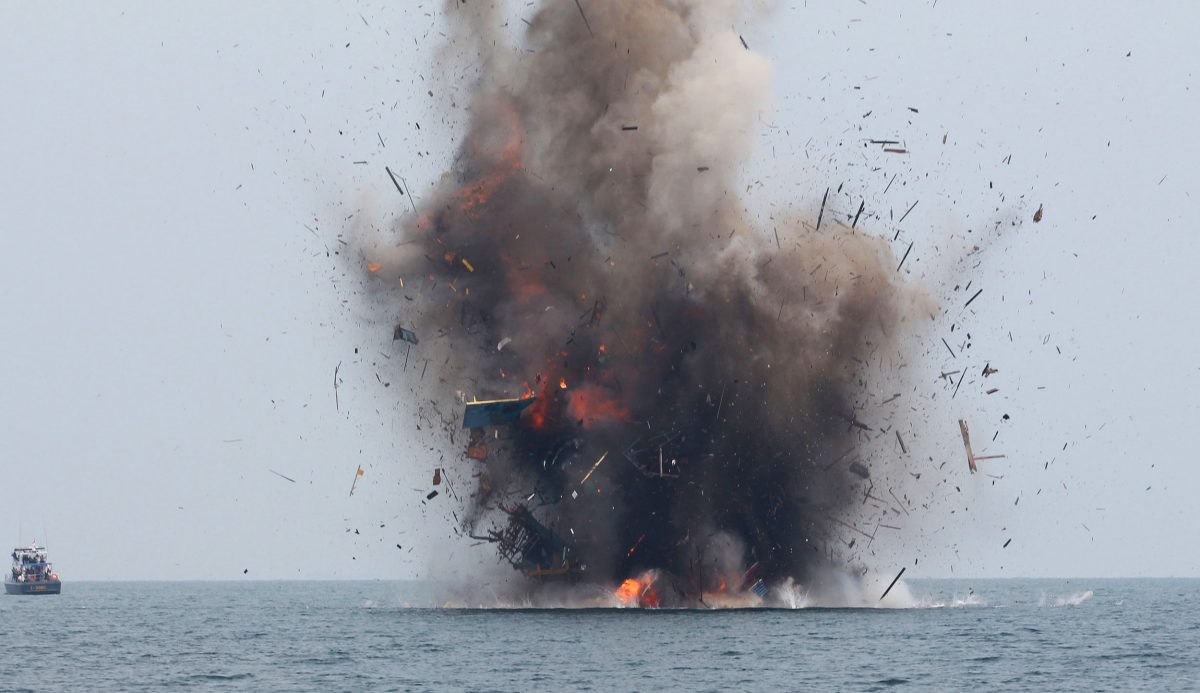
The Indonesian government takes an aggressive approach to defeating illegal fishing vessels, claiming to have sunk hundreds of such ships in its waters. Photo by Januar/AFP via Getty Images
“We knew it was approaching Indonesia, but we hadn’t seen it in a long time,” Bergh says, referring to an 18-hour period when the STS-50’s signal went dark. “Everyone was asking, ‘Where is it? Where is it?’”
Finally, they saw it—a little blip coming toward Banda Aceh.
As soon as the STS-50 entered Indonesian waters, two Indonesian navy vessels intercepted it and asked to board, which the captain and crew allowed. Usually people on board fishing vessels don’t resist, says an official who asked not to be named. Especially with Indonesia’s reputation: “How do I put it?” he says. “They’re very … efficient … with law enforcement.”
On the high seas, the bad guys have almost always gotten away—a frustrating reality of the seemingly Sisyphean task of policing lawbreakers in such a vast arena.
By the time the Ocean Warrior arrived back in Dar es Salaam and refueled, only four days of its originally scheduled patrol were left. Dicks steered the vessel up the Tanzanian coast toward the Kenyan border and arrested a rickety wooden boat that was smuggling migrants. “Small fry, really,” says Dicks.
The STS-50 managed to fish illegally for years because its captain had a knack for making the ship scarce. This animation, intended to illustrate the timeline of the STS-50’s capture, provides only an approximation of the ship’s route across the ocean. Animation by Katrina Pyne
The STS-50 was not small fry, but punishing those responsible for the vessel’s crimes proved more difficult than catching it. The captain was sentenced to a mere four months in Indonesian prison and fined $14,000 by an Indonesian court for illegal fishing. The other officers were deported back to Russia and Ukraine, their home countries. Still, punishing the real perpetrators was more difficult.
“To this day, we still can’t target the owners,” Pudjiastuti said at a press conference at her office in Jakarta, Indonesia, in early 2019. “The beneficial owners aren’t clear, so it’s difficult for us to track them down.”
After the arrest, Interpol’s digital forensics teams pored over the intelligence contained within the fishing vessel—its on-board computer systems, navigational instruments, and the captain’s mobile phone—helping authorities piece together the wider criminal web that the vessel operated in. Rather than blow up the captured illegal vessel, Indonesia has converted the STS-50 into one of its maritime policing boats.
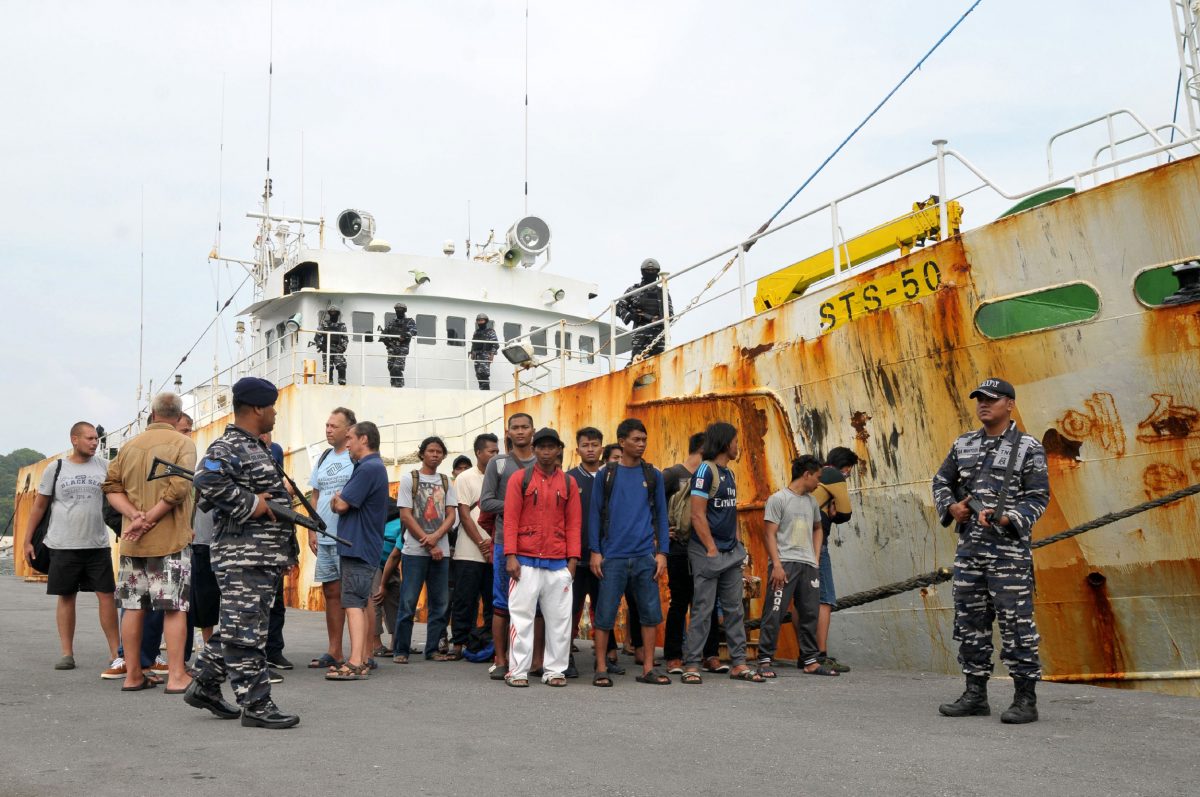
Indonesian guards stand with crew members from the STS-50 after the ship’s capture in April 2018. Photo by AFP via Getty Images
In the fisheries management world, many people see capturing illegal fishing vessels as government work. That attitude has always frustrated Bergh. If illegal vessels can easily slip between borders, capturing them requires not only governments—which tend to have limited and confidential intelligence—but also, evidently, many other players working together. “These cases are puzzles,” he says. Some organizations dedicate years to investigating certain criminals or cases—when that hard-won information is shared with other agencies, everyone benefits, he adds.
For Bergh, the apprehension of the STS-50 demonstrates what is possible when governments, law enforcement, and civil society work across the political boundaries that once constrained them. And though Bergh acknowledges that stopping one vessel doesn’t turn the tide against illegal fishing, it does show that the net is tightening.
Correction: A previous version of this story incorrectly stated that 312 IUU fishing vessels are in operation. The number has been updated.

